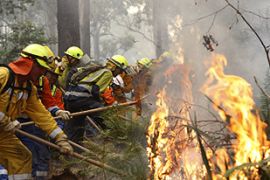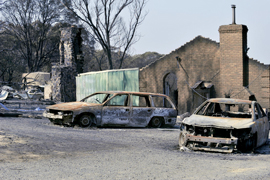Australia’s fire warnings ‘flawed’
Invesitgation finds residents were not given enough warning to flee deadly blazes.

The fires ripped across the state of Victoria in early February, and were the deadliest in Australian history, killing at least 173 people and destroying more than 2,000 homes.
The speed and ferocity of the fires overwhelmed firefighters and caught many
off guard, with some victims complaining they had no notice of the looming danger.
The commission, led by Bernard Teague, a former Victorian supreme court justice, said warnings during the fires were inadequate.
“There were a number of weaknesses and failures with Victoria’s information and warning systems,” the report said.
‘Delayed warnings’
“Warnings were often delayed which meant that many people were not warned at all or the amount of time they had to respond to the warnings was much less than it should have been. The warnings that were issued often did not give people a clear
understanding of the location and severity of the fire and how they should
respond.”
 |
| The fires killed close to 200 people and destroyed over 2,000 homes [AFP] |
Since the fires, the government approved the creation of a national disaster alert telephone service that will automatically send warnings for a range of disasters to mobile phones and landlines.
John Brumby. the Victorian state premier, said the system should be in place by the start of the next bushfire season, which usually begins in November.
“In relation to communication and some of our technology, these didn’t work as well as they should have and could have on that day,” he told reporters in Melbourne.
Brumby also said the government has already put in place many of the 51 recommendations the commission listed in its report, such as providing emergency responders with better equipment.
Since the fires, questions have revolved around the policy of allowing residents in high-risk areas to decide for themselves whether to stay and fight the fires or flee.
The policy recognises that Australia’s wildfire services lack the resources to protect every house. Homeowners are therefore allowed to try to protect their property.
But the report found that 113 of the victims died while trying to defend their homes.
The commission said the policy fails to emphasise the dangers associated with staying behind, and recommends officials stress that leaving early is the safest option.